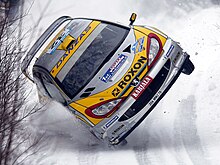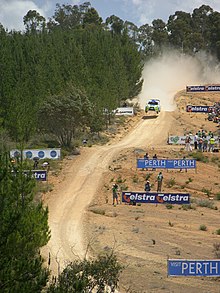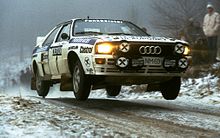rally

The rally [ ˈrali or ˈrɛli ] ( French rallye , English rally ) is a competition in motorsport that is sometimes held over several days ( stages ) on normal roads or on field and forest paths. Instead of driving “always in a circle” as in races on a circuit and fighting for positions, the rally participants carry out special tests on closed-off routes (from point A to point B), usually starting individually every minute. The scoring is based on the sum of the driving times in the special stages. The participants get to the special stages via connecting stages in public road traffic. For this reason, only street-legal cars are used.
A global series of currently 14 rallies with their various special stages is combined in the FIA World Rally Championship .
Concept history
Rallye is an English and French word. The English verb rally (" bring together", "collect" or "gather together"), which has been used since around 1600, goes back to the French rallier ("collect", literally re + allier = "reunite"). Around 1650 the English noun rally came up, initially in the sense of "gathering the military forces after a setback". From this, the general meaning “gathering” developed for the noun rally . The meaning of "major event at which the masses are whipped up" is first recorded in American English in 1840. The Nuremberg Party Rallies are called Nuremberg Rallies in English .
The special meaning "organized meeting of enthusiastic motorists" first developed in French, there with the spelling rallye (where French rallye is derived from English rally ). This newer meaning has also been used for the English word rally since 1932 . In German, the French spelling was adopted: Rallye . However, in connection with internationally used names, the English spelling also appears in German, for example World Rally Championship . With reference to rallying, the word also found its way into many other languages: for example Danish, Swedish, Dutch and Italian rally , Finnish and Turkish ralli , Hungarian rali , Romanian raliu . In some languages there are competing spellings, for example in Spanish rally and rallye , and recently also rali .
The Duden admitted rally until the 21st edition (1996), which meaning is " car rally ". This long outdated statement goes back to the historic Monte Carlo Rally , which was launched in 1911 as a meeting of motorists from different countries. The participants started in their home country, for example in Germany in Bad Homburg vor der Höhe , in a city known like Monte Carlo for its casino . The joint driving tests began in France even before Monte Carlo was reached. The character developed from a touristic orientation drive through a reliability test of the vehicles to today's usual competition with the aim of achieving the shortest possible travel times on the special stages. With the 22nd edition (2000), the Duden updated its entry rally and stated the meaning: "Car races [in one or more stages] with special stages".
Rally structure and role of the passenger
A rally is divided into connecting stages in public road traffic, in which all participants must strictly adhere to the applicable traffic rules (e.g. control over specified target times and also by the police), as well as the special stages. On these specially cordoned-off roads and paths (asphalted or on a different surface, usually gravel, in winter also on snow and ice), each vehicle is individually against the clock . In rather rare cases, the competitor driving ahead can be caught up with, but this is mostly due to a defect in his car or to a driving error he has committed. Normally, the fastest start first, whereby the vehicle class is sorted so that the participants in each class can find the same conditions as possible.
Strict time specifications also determine the course of a rally. These must be complied with exactly to the minute. There are time penalties for arriving too late or too early at time controls (ZK), before the start of special stages and at the entrance and exit of service parks.
Some rallies contain an additional Super Special Stage in addition to the actual special stages . Here two drivers compete against each other, but the vehicles are not on the same route, but on two parallel courses. The courses are usually comparatively short. These tests usually extend over a day or a whole weekend because all drivers in the event have to start.
Copilot
Characteristic of a rally is the copilot (co-driver), also known internationally as a navigator, who on the special stages with a note dictated by the driver during inspection drives and recorded by the copilot (the " prayer book ") to the driver, distance information and curve radii as well as jumps, surface changes and other Announces peculiarities of the roadway (ie "pray in advance"). This is an important contribution to the success of any team and requires a high level of mental and physical performance from the co-pilot. In addition, the co-driver ensures that the specified section times are strictly observed and at the beginning and end of a section he has the boarding pass (= control card from the rally organizers) stamped at the time controls . Officially, the vehicle crew in a rally consists of the 1st driver and the 2nd driver and the co-driver is allowed to drive the car himself under competitive conditions. This can be necessary, for example, if the driver injures himself during the competition or if his driver's license is withdrawn because of a speed limit on the connecting stages.
Service times
In rallies, service times are usually provided (e.g. 20 minutes each), during which the participants have to drive their vehicles twice (sometimes three times) to specified service parks. There repairs can then be carried out by mechanics. At the end of the day this service time is e.g. B. 45 minutes before the vehicles are locked overnight in a guarded area, the Parc Fermé . Outside of a service park, only the driver and front passenger are allowed to carry out repairs, and for this they are only allowed to use spare parts and tools carried on board.
Rally 200
As a popular sporting event for amateurs, there are a number of so-called Rallye 200 in Germany, in which a total distance of a maximum of 200 km is covered. A maximum of 35 km of this route consists of the special stages, which are closed roads (mostly dirt roads, some industrial areas or military training areas , but sometimes also normal roads and even through-town roads ) that have to be driven as quickly as possible. The remaining up to 165 km are connecting stages from the end of one special stage to the start of the next special stage. These connecting stages are public (i.e. not closed) roads that must be driven in compliance with the road traffic regulations . In addition, the teams are given by the organizer how long they have to need for the respective connection stage, whereby in particular falling short of this requirement leads to significant time penalties .
The necessary permits for WPs are usually difficult to obtain because, among other things, nature conservation issues and the concerns of residents have to be taken into account.
In addition, the Rally 200 regulations stipulate the maximum length of a special stage and also require that the same special stage may only be driven a maximum of three times. Due to these framework conditions, it has become very common that Rally 200 events manage with three different special stages, each of which is driven twice. However, there are also Rally 200 events that offer six or even seven different special stages (e.g. the ADAC Grabfeld rally).
Anyone who is in possession of a driver's license can take part in a Rallye 200, whereby an event license (also called a day license) can usually be acquired (this is only valid for one event). However, it is not possible to take part in a normal car, as this would at least have to be equipped with a roll cage and a hand fire extinguisher . Apart from this, other technical regulations must also be complied with. For example, stipulate the type of permitted modifications and, last but not least, limit the maximum engine power, as in all other rallies, to 300 hp. Compliance with these regulations will be checked by so-called technical inspectors before the start of the event. Since a Rally 200 also takes place on public roads, the driver must also be in possession of a (valid) driver's license and the vehicle must comply with the road traffic regulations (in particular, all modifications must be entered in the vehicle documents).
However, with a "normal" series vehicle there is hardly any chance of being very successful, as cars that have been specially converted for rallies have to be competed. Thanks to a subdivision into different groups (e.g. for production vehicles or for improved cars), which in turn are divided into different classes according to cubic capacity or power to weight ratio , it is nevertheless ensured that actually every participant in a Rally 200 drives for victory - and is it is "only" about the class win.
Oldtimer and youngtimer rallies
In some rallies, vehicles are moved that have not been built for many years. One generally distinguishes between vintage cars older than 30 years of age, and the so-called modern classics include the younger model years from the age of 20 years. There are rallies in which the youngtimers keep to themselves, such as the Cologne-Ahrweiler rally , which is part of the youngtimer championship .
The sporting demands of the competitions for vintage vehicles vary greatly. In the majority of the events, the sporting aspect is limited to the awarding of trophies to the best points in a special evaluation (derogatory term: "coffee trip"). However, there are also old-timer rallies that present difficulties for the driver and co-driver (e.g. orientation tasks or regularity tests with hidden time controls) and in which only fast drivers with knowledgeable co-drivers can achieve good placements. Such events take place more frequently in Great Britain, Belgium or France than in Germany.
Rally offshoot
Rally raid
The Dakar Rally is not a rally in the current sense of the word , nor is it a similar type of competition such as the Baja races in Mexico and California (USA). The "Dakar" and some other desert trips in North Africa or the Middle East are rather so-called rally raids , which, in contrast to a normal rally, do not take place on temporarily closed roads and dirt roads, but mainly in open terrain (or off road or cross country ). In addition, different types of vehicles take part in a rally raid in separate ratings - mostly off-road vehicles or buggies , as well as motorcycles , trucks or trucks and quads .
Rallycross
Rallying is also the root of rallycross . On February 4, 1967, on the specially prepared Lydden Circuit (between Dover and Canterbury in Kent , England ), invited rally drivers were allowed to compete against each other in groups of four in short sprint races for an ITV TV production in direct comparison (the winner was the later Formula 1 driver and Monte winner Vic Elford ). As a result, the organizers launched a completely new auto sport called rallycross, in which the rally factory drivers were soon replaced by real rallycross specialists who were now growing up. The most successful ex-rallycrosser on the rally scene is the 2003 world rally champion, the Norwegian Petter Solberg . “Hollywood” was almost unbeatable in the Norwegian National Rallycross Championship for a number of years in the early 1990s, until he switched to rallying in 1997. In the meantime he has returned to his original discipline and secured the World Rallycross titles there in 2014 and 2015.
Rally sprint
According to current knowledge, the birth of all rally sprints was the so-called Mini Monte from Brands Hatch ( Kent ) in southern England. In February 1963, Raymond Baxter , who worked for the Sports Department of the BBC , had a series of Mini Rally Stages (German mini special stages ) staked out in the parking lot of the circuit south of London . Back then, a single car fought on a very foggy day for the fun of hundreds of thousands of TV viewers both against the terrain, badly deformed by slush and mud, and against the timekeepers' stopwatch. In the end, victory went to the Finn Timo Mäkinen, who had driven his rally works car, an Austin Healey 3000 , as the fastest over the slippery slopes. It was not until a few years later that such compressed rallies became a completely new auto sport discipline under the name rally sprint.
The British continued to like to organize rally sprints for the entertainment of the TV audience. B. in the 1970s and 1980s at the Donington Park Circuit . Here, some World Rally Championship drivers and Formula 1 drivers competed against each other with equivalent vehicles and had to prove themselves both on the asphalt track and on gravel roads in Donington Park , with the British rally driver Tony Pond in particular taking off with several overall victories .
In other countries, however, these rally sprints developed into a completely independent racing sport. Often only a single rally special stage is completed several times and, if necessary, driven in the opposite direction on the second run. Usually the times driven are then added up to determine the overall winner.
Formula Rallye and Formula Rallye Germany
As part of the Motor Show of Bologna in Italy, the organizers held in December 1985, the first show race of rally drivers under the term Formula rally . To commemorate the rally driver Attilio Bettega , who had died in an accident a few months earlier , it became a success in his home country as Memorial Bettega , which continues to this day. In one occupied by some 50,000 spectators Arena had a created "Mickey Mouse course" (going from different starting positions on the grid) on the two actors through a knock-out system through preliminary rounds, quarter- and semi-finals in the finals to the Overall victory fought. The reigning world champion Timo Salonen from Finland proved his dominance and that of his Peugeot 205 T16 E2 and snatched the first victory under the nose of his compatriot Markku Alén in the Lancia Delta S4 (and thus also the Italian host Lancia).
This rally offspring came to Germany as Formula Rallye Germany in September 1987 and was able to establish itself for several years on the Gründautalring von Gründau -Lieblos near Frankfurt am Main .
Race of Champions
The lucrative stadium and media spectacle launched in 1988 by former factory rally driver Michèle Mouton from France and her Swedish companion Fredrik Johnsson can also be called a mixture or crossroads of the three rally offshoots rallycross, rally sprint and formula rally Look at the Race of Champions .

Ice races
Last but not least, the so-called Trophée Andros ice races, which are extremely popular in France, have their roots in rallying. As early as the 1970s, car ice races were contested in the winter sports centers of Chamonix (24h sur Glace de Chamonix) and Serre Chevalier with rally cars that were still relatively tame at the time in the French Maritime Alps . Later the participants developed far more efficient vehicles for this; for the Andros trophy, almost exclusively very potent prototypes with all-wheel drive and synchronized steering of the front and rear wheels.
Web links
- Official World Rally Championship website (English, French, Spanish)
Individual evidence
- ↑ a b c Online Etymology Dictionary: rally , see verb 1 and noun.
- ↑ Duden Volume 1, Die Deutsche Rechtschreibung , 21st edition, 1996, p. 604.
- ↑ Duden Volume 1, Die Deutsche Rechtschreibung , 22nd edition, 2000, p. 790.
- ↑ See the current information on rally at Duden online: "Competition for series-produced vehicles in one or more stages with various special tests".







